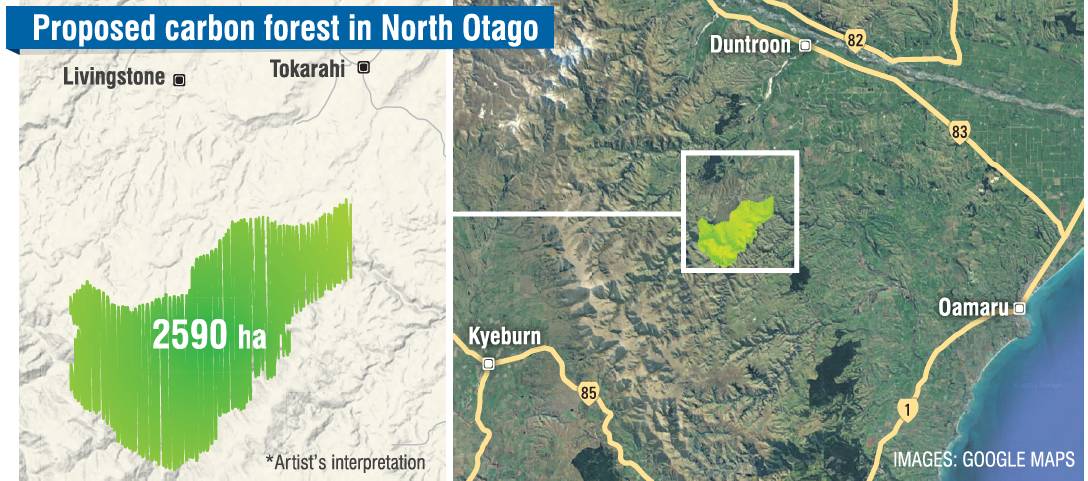
"I just think it’s an absolute injustice, it’s a crime to have that land put into trees."
North Otago farmer Murray Simpson has farmed Balmoral, near Tokarahi, for 45 years. The property neighbours Hazeldean, a 2590ha sheep, beef and deer farm in the headwaters of the Kakanui River catchment which appears destined to be planted out in pine trees.

The property is in the throes of being sold to New Zealand Carbon Farming — the largest provider of carbon credits in Australasia. Not mincing his words, Mr Simpson fears the development will be "an absolute shambles".
Mr Simpson and his wife, Judy, along with several other local farmers, the Kakanui Water Allocation Committee, Kakanui Camp Society, North Otago Federated Farmers, Central South Island Fish and Game Council and North Otago Irrigation Company recently wrote to Waitaki Mayor Gary Kircher, expressing their concerns.
Their main focus was on water quality and the effects on the environment in a catchment that was of "undisputed importance" to North Otago and to the communities and stakeholders whose "lifeblood" depended on it, but which was also a catchment under pressure.
Farmers have also expressed concerns that such forestry conversions were being allowed to go through without the "checks and balances" they believed changes to other land uses would necessitate.
Mr Simpson has had a lifelong tie to the the Kakanui River; he grew up at Kia Ora, playing and swimming in the river as a child.
He moved to Balmoral in 1975 and also had a long association with Hazeldean. For decades, he and a previous owner helped each other out on their respective properties.
"I know [that] property as well as mine. Over the 45 years that I’ve been here, I’ve developed quite an attachment ... to both properties," he said.
While the Simpsons were in the process of selling their own property, Mr Simpson and other farmers were prepared to speak out on the proposed sale, saying their main aim was to make the public aware of what was going to happen and the effects it could potentially have.
If the environment could cope with the plantation, then there was no issue. That was the same if New Zealand Carbon Farming could control the pests on the land, but he feared they could not in an area that big.
About 12 months ago, wilding pines were removed from the area and yet pine trees were being put back in — "What’s the sense in that"? he said.

In their letter, the signatories said they were not opposed to forestry; integration of both native and plantation forestry into existing farming operations might assist with meeting New Zealand’s climate change commitments, landscape resilience, improving water quality and animal welfare.
Equally, the opposite was true. There were instances of forestry being planted where significant areas of indigenous vegetation had been cleared, historic and cultural sites destroyed, and water quantity and quality of the catchment negatively affected.
Forestry also provided fewer jobs than farming operations.
Fewer jobs meant fewer families in the area, fewer children in schools and less spending in towns.
Most of the benefit from incentives such as carbon credits went to the landowners rather than local communities, as forest owners frequently lived remotely from their plantations, they said.

The Kakanui River was the source of water for four community water supply schemes. It had particular tribal significance to Te Runanga o Moeraki which was reflected in its status as a Statutory Acknowledgement Area.
Large areas of significant indigenous vegetation were prevalent on the land surrounding its headwaters. There were also many remnants of old stonework in the area including rare stone yards, huts and middens.
In the Otago Regional Council’s water plan, the area above Clifton Falls was acknowledged as an area with a high degree of naturalness, as well being a significant habitat for longjaw galaxiid which had a threat status of "nationally critical" and koaro and lamprey, both of which were in decline nationally.
The river was a locally significant brown trout fishery and game bird habitat and provided recreational opportunities to the surrounding communities.
It was a catchment that was under pressure, with decreasing flows impacting on water quality, aquatic life and the health of the estuary.
The signatories were concerned the planting of large areas of forestry would result in those values being lost and further reduce the catchment’s water yield, exacerbating pressure on the water body.
Tall vegetation’s impact on water yield was through higher interception loss, leading to less water for stream run-off and groundwater recharging.
Five Forks dairy farmer Lyndon Strang, who has been active in the water quality arena, said farmers concerned about the development did not want to be seen as a group of "not in my back yard" types.
He believed there were no "checks and balances" for that land use change. If there was going to be land use change — whether 1000ha planted in hazelnuts or converted to deer farming — there were going to be implications on water. Carbon farming and forestry needed to go under the same close scrutiny as any other land-use change.
The dairy boom initially went through "pretty much unchecked" and the price was probably being paid now, he said.
Mr Strang did not want to see the same thing later from forestry; if it was going to happen, it had to be in the right place with the right measures around it.
Much work had been going into remediation in the Kakanui catchment and farmers "pulling up their socks".
Something of the scale of that forestry in such an important part of the catchment could be a "massive step back".

Those farmers speaking out were not against planting trees. But Mr Strang suggested a better approach would be for farmers to be incentivised to plant the worst 5%-10% of their land in trees — do that across the catchment and there would be a large number of trees within 10 years — "and you don’t need to trash a perfectly good farm".
Those behind that development did not appear to have the likes of firebreaks, firefighting ponds and pest management control plans before they got under way, he said.
Five Forks sheep and beef farmer Jane Smith, a former winner of the national Ballance Farm Environment Awards, feared the development could set a precedent for the rest of the country, if the sale went ahead.
Potentially there was also a domino effect in the wider community with the removal of livestock from the property.
And if a kilogram of protein was not produced here, then someone else in the world had to do it to meet demand using a "way larger carbon footprint", Mrs Smith said.
There were concerns resource consent was granted retrospectively by the Waitaki District Council to New Zealand Carbon Farming for an activity like the Hazeldean proposal.
It was sought for clearance of indigenous vegetation, failure to meet setbacks from neighbouring properties without written approval, and earthworks and planting within 20m of streams and wetlands at Tokarahi.
"Conditions were imposed on the consent and, from our observations, few of the conditions have been complied with, and there has been a failure on the council’s part to ensure compliance," the letter to Mr Kircher said.
The effects of seeking that retrospective consent had been emphasised by the "abhorrent lack of adherence" to the conditions of consent, it said.
The forestry was a fuel source for devastating fires that occurred in October last year and was a habitat for deer, pigs and wallabies.
As well as increasing the level of pest control required, the increase of such animals could further contribute to the decline of indigenous vegetation.
The blaze, in a New Zealand Carbon Farming pine forestry block near Livingstone, burnt through 611ha and led to a public meeting where farmers asked if there was a plan to install more water in the area to help fight fires.
Mr and Mrs Simpson had a traumatic first-hand experience with that fire; they were forced to flee their home and feared their house would not be standing when they returned.
Mr Simpson received a phone call from a neighbour at 3.45am and was told to look out the window. He saw the plantation on fire but it "wasn’t the biggest shock I’ve ever had" — he had been "waiting for it to happen" as it was a thick plantation and there were no firebreaks.
The nearest water was 5km away and Mr Simpson said the neighbours were essentially used as firebreaks.
Their house was saved by the wind; they lost a haybarn and machinery to the blaze and, if a helicopter had arrived five minutes later, they would have also lost their workshop and woolshed. The fire reached the back of the workshop at the same time as a helicopter arrived.
Given that conversion of any land in the headwaters of the catchment to forestry would require the same scope of works, the signatories envisaged resource consents would also be required.
They considered any potential adverse effects on the values of the catchment could be more than minor and public notification of any application should occur. They requested the council take "a very dim view" of any attempt to retrospectively seek resource consent.
Long term, the group said they would be actively participating in the Waitaki district plan review, as well as working with the Otago Regional Council to co-develop a planning framework in regard to large scale conversion of land to forestry that better aligned with community expectations and outcomes.
Hazeldean has been owned by the Hannon family since 2007 when they moved down from the North Island, intending to stay for 10 years.
John Hannon spent years dreaming of developing a larger farm. Selling the property, due to a variety of reasons, was the hardest thing he had ever done, he said.
Mr Hannon was very concerned about water quality, how the development would affect the neighbours, and about the stone yards and hut on the property. New Zealand Carbon Farming had given him assurances that his concerns would be its concerns, he said.
He lived "in the healthiest place in New Zealand with probably the biggest fire danger", he said.
When approached for comment, New Zealand Carbon Farming provided a statement to the Otago Daily Times.
As the owner and manager of the largest New Zealand-owned permanent forestry estate, it was a significant contributor to New Zealand’s climate goals.
Over the past decade, more than 20million tonnes of carbon had been captured by New Zealand Carbon Farming’s forests — the equivalent of having no cars on New Zealand’s roads for a year. New Zealand Carbon Farming’s forests stored a tonne of carbon every 13 seconds.
"New Zealand Carbon Farming establishes permanent regenerating carbon forests. These are forests that are planted in pine then actively managed to return, over time, to 100% indigenous forests — providing a rich habitat for Aotearoa’s unique native flora and fauna.
"This science-backed approach creates a protective nurse crop for native trees, while also maximising how much carbon is captured in the early stages of forest growth.
"The process makes preservation and active management of any native forest area within our forests vitally important. These areas form an important, biodiverse reservoir to help support the native regeneration process," the statement said.
More than 95% of New Zealand Carbon Farming’s 66.7million trees under managment for carbon were planted on low productivity land (grade 6 and above) — including marginal, steep and erosion-prone land.
"We also carefully manage all of our forests — employing local people to work year-round on tree and estate management, predator control and enhanced native tree growth," it said.
Comments
Hard to make a profit from a native forest, with hard dense wood, and native wild life.
This talk of saving the environment by planting exotic monocultures always reminds me of the famous Vietnam war quote: "We had to destroy the village in order to save it."
Planting the wrong trees in the wrong place can without doubt do more harm than good. Research has been carried out and the scientists have handily come up with guide. Here is what they recommend in a paper published in the journal Global Change Biology.
1. Protect existing forests first
2. Put local people at the heart of tree-planting projects
3. Maximise biodiversity recovery to meet multiple goals
4. Select the right area for reforestation
5. Use natural forest regrowth wherever possible
6. Select the right tree species that can maximise biodiversity
7. Make sure the trees are resilient to adapt to a changing climate
8. Plan ahead
9. Learn by doing
10. Make it pay
Is there a plan to stop burn off and practices that may facilitate fires?
Why are they selling?
When a farmer starts complaining about "green initiatives" being planned in his neighbourhood my immediate reaction is suspicion and doubt over his integrity. Let's face it, the agricultural community in general and farmers specifically have an atrocious record when it comes to conserving and protecting the very environment they rely on for making a living. They are exploiters of the first order.
They have opposed every conservation initiative that has been introduced. Remember riparian planting, they opposed that and had to be forced to participate. When the practice proved itself to be effective they claimed it as their own.
Their outlook has always proved to be selfish and profit driven. Their arguments are emotive and not based on science.
Its an investment with a ~20 year maturity. Pine does nothing for native species except possums and cash crops.
When ird starts complaining on here, my immediate reaction is: here we go again. Let's face it, you will believe everything of what your party has told you without question - even if it concerns farmers which are the lifeblood of the country with their exports. How many logs were exported again? But yeah, way to follow your party's ideology of farmers are bad, eh.
Sorry to tell you nivaman but I do not belong to any political party. And I certainly do not believe everything I'm told. Any review of my comments on here will confirm that I take an unbiased and independent view on the issues that concern me.
However, I must take issue with one of your claims. I do not believe farmers are the lifeblood of the country with their exports. You appear to have swallowed this particular fallacy, hook, line and sinker. Our primary exports, which I agree are essential to our economy, are the result of a long, co-dependent chain of performers, not just farmers.
It doesn't matter which link the farmers are in the chain if any one of the links fail then the life blood stops flowing. Agricultural contractors, transport operators, freezing works, dairy factories, the electricians, engineers, mechanics and technicians that keep them all running, even the bureaucrats who negotiate the trade deals, they all form equally essential links of the chain. As I've said, the farmers are just one link, no more, or less, important than any other in the chain.











